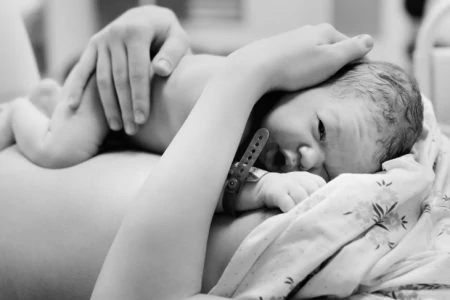Knowing your baby’s position can help you prepare for labor, but it’s not something they teach you at your prenatal appointments.
Belly mapping is gaining popularity as an at-home method of recognizing your baby’s position in the womb. It empowers moms to approach labor confidently and can also be an opportunity for other family members (like a partner or siblings) to participate in the pregnancy.
Through careful research of belly mapping and our own successful experiences with it, we’ve learned how to determine a baby’s positioning in the weeks before birth.
In this article, we’ll teach you how to use belly mapping, so you can know if your baby is in the best position for delivery without having to wait and wonder until your next prenatal appointment.
Key Takeaways
- Belly mapping is a way of determining a baby’s position in the womb at home prior to labor. It can be done after the 30th week of pregnancy.
- To do belly mapping, you need to be in a quiet, comfortable spot and have a nontoxic marker or paint, paper, and a baby doll. You need to locate the baby’s head by applying gentle pressure to the upper part of the pelvis or pubic bone, find the baby’s back by feeling for a long, hard, smooth mass, and visualize the baby’s position by using a doll prop.
- Belly mapping can empower moms to approach labor confidently and can also be an opportunity for other family members to participate in the pregnancy.
What To Know Before Belly Mapping
- The best time to do belly mapping is after the 30th week (or 7-8 months) of pregnancy (1).
- It may be easier to map your belly after an appointment with your doctor or midwife because the professionals can help you get an idea of the baby’s general position.
- Certain factors such as the placement of your placenta, amniotic fluid levels, and tummy tone affect how you feel the sensations of kicks and bumps, which help you map your baby’s body parts (2).
- Choose a time when your baby is usually active, and ensure you have a comfortable, quiet spot to relax.
Before you start, watch this video inspired by the pioneer of the Belly Mapping process, Gaily Tully.
What Do I Need?
- An appropriately pregnant belly (of course!).
- Paper (if you prefer to make your map on paper instead of your belly).
- A nontoxic marker or paint.
- A baby doll (to help you visualize your baby’s head and limbs.)
How To Do Belly Mapping
1. Locate Your Baby’s Head
Get comfortable in a quiet space where you can concentrate on your baby’s movements without distraction for at least 15-30 minutes. Sometimes it’s easier to recognize your baby’s position if you are at least partially reclined or, if it’s not too uncomfortable, on your back. Just make sure that you’re tipped on one side, and not fully flat on your back.
Relax and breathe deeply and slowly to feel more movements.
Using your fingertips, apply gentle pressure to the upper part of your pelvis/pubic bone. If you feel something round and hard, it’s likely the head.
If what you feel is rounded but softer, it’s probably your baby’s bottom. You may also try grasping and gently wiggling the body part – the head would tilt or move independently while moving the bottom would shift your baby’s entire body (3).
Take Note
Your baby is also likely head down if you’ve felt hiccups lower in your belly.
Once you’ve determined your baby’s head position, mark this area with a circle either on your belly or the paper.
2. Find Their Back
After finding the head, move your hands along your stomach, feeling for a long, hard, smooth mass. This indicates the position of the baby’s back.
Sometimes you will feel it fully on one side of your belly or another. Mark this with a curved line either on your paper or your skin.
If you can’t feel any hard mass, this could mean their back is in line with your back, in a posterior position. In this case, you may feel more limbs or a softer mass which is your baby’s tummy as opposed to their spine.
3. Use Your Doll Prop
Based on the positioning of the circle and line on your tummy, you have an idea of where your baby’s limbs may be.
Now, move the doll around to mirror what you already marked on your belly, and use the sensations of kicking and the movement you feel to visualize your baby’s position in the womb.
You can also mark kicks and movements with dots or waves corresponding to the sensations, to give you a sense of the movement pattern. Are all the kicks on one side, indicating the direction of your baby’s legs? Do you feel flutters down low, indicating they’re stretching their arms in that area?
4. Know The Different Baby Positions
The most commonly known positions for babies to be in are either head down or breech, but did you know these are not the only possible positions?
- Head Down – 97% of babies will be in the head-down position by the time labor begins after 37 weeks.
- Breech – there are multiple breech positions, depending on the baby’s legs and feet. The baby may be bum down, feet down, or cross-legged.
- Posterior – This is sometimes referred to as “sunny side up,” where the baby faces outward towards the mom’s belly button.
There are also a variety of other possible positions your baby can be in, and head down is not the only determinant of ideal baby positioning. The Spinning Babies website explains other ways babies might present and how it impacts labor and birth.
Your baby’s position in-utero can also change frequently, especially in the first and second trimesters, while they still have lots of room for movement (4).
Depending on how far along you are, there are many options you can discuss with your health care provider. These may include at-home exercises, alternative therapies, and doctor-led treatments to move your baby into a head-down position.
Of course, the first step is to verify the baby’s position with your healthcare professional. Take any next steps only with their guidance and advice.
What Should I Do Next?
Your visual map of your baby’s positioning should now include the following:
- A circle marking the location of the head.
- A curved line displaying your baby’s back.
- Any movements and patterns you’ve chosen to map.
You can take things one step further by turning your map into a beautiful work of belly art by using paint to create an artistic representation.
We’ve seen some beautiful examples of this, and it could be fun for all you creative mamas to try!
Belly Mapping FAQs
The Bottom Line
Belly mapping can be a wonderful exercise to include other members of your family in your developing pregnancy. Partners can help feel your belly for your baby’s position, bringing them closer to you and your growing baby. Siblings may even enjoy marking movements based on your cues.
It can be reassuring if your baby is head down from 32-34 weeks on. However, some moms place a lot of importance on specific positioning. Some positions promote easier labor and vaginal birth, but the baby’s position can change tremendously during labor. As you enter the last trimester, there are some things you can do to promote an easier labor position. Move often, use proper posture, and sit upright. However, the most important intervention is to relax and trust your body. Often, babies flip to the perfect position during labor.
Editor's Note:
Caitlin Goodwin, MSN, RN, CNM










